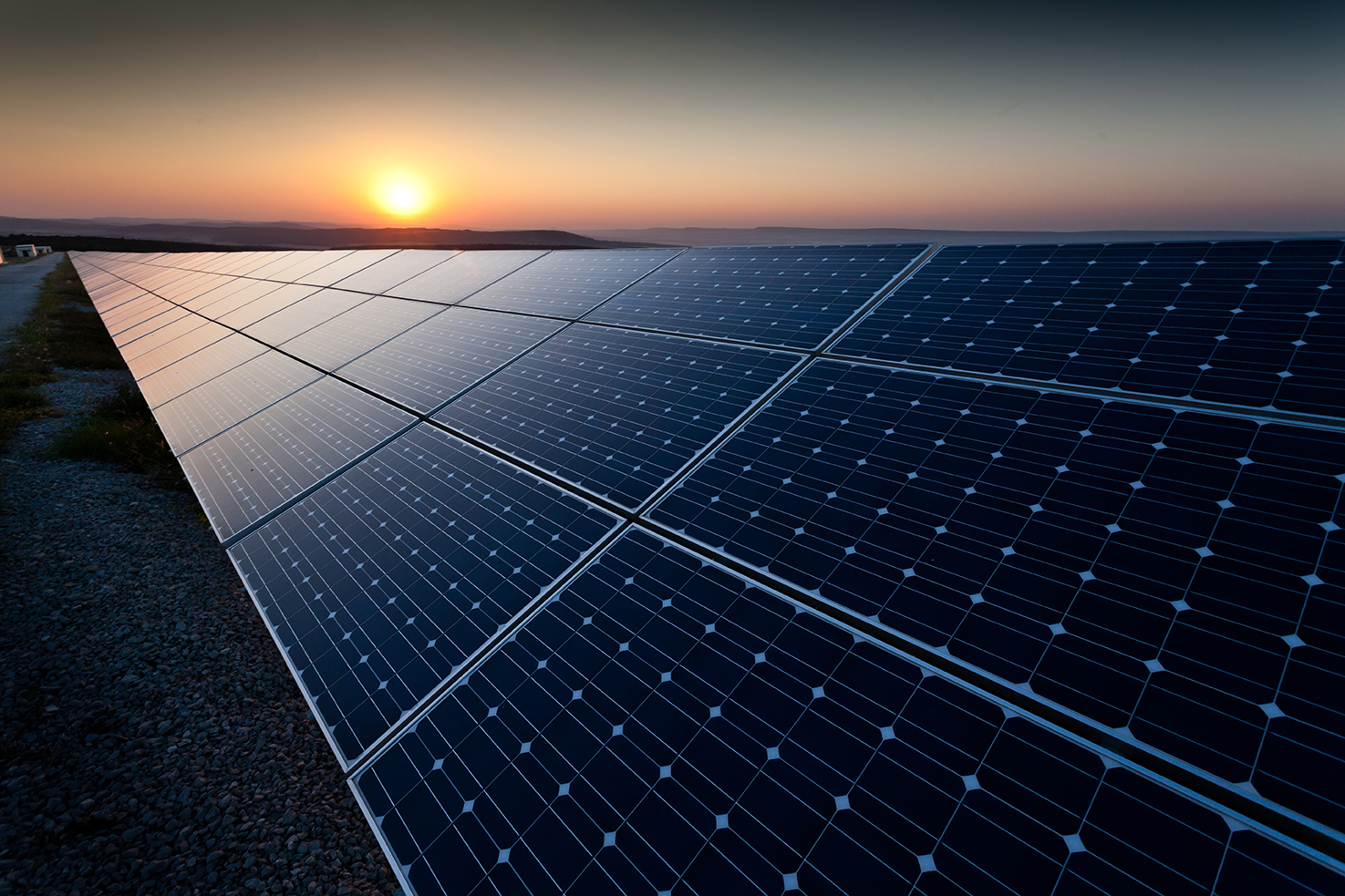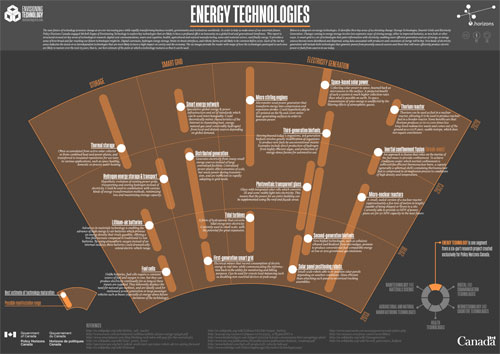Energy Technology

On this page
Related Reports
Overview
What are you looking at
Storage
Smart Grid
Electricity Generation
References
Figure 1 : Energy Technologies

Related Reports
Digital and Communication Technologies
Neurotechnology and Cognitive Technologies
Agricultural and Natural Manufacturing Technology
Nanotechnology and Materials Science
Health Technologies
Overview
The near future of technology promises change at an ever-increasing pace while rapidly transforming business models, governments and institutions worldwide. In order to help us make sense of our uncertain future, Policy Horizons Canada engaged Michell Zappa of Envisioning Technology to explore key technologies that are likely to have a profound effect on humanity on a global level and generational timeframe. This report is structured around six key areas of technological research: digital and communications, neuro and cognitive, health, agricultural and natural manufacturing, nano and material science, and finally energy. It provides a sense of how broad and far-reaching our future technologies might be. Digital currencies, hydrogen energy storage, brain-to-brain interfaces, and robotic farms are all likely to be common before 2030. Each of the six key areas indicates the dozen or so interdependent technologies that are most likely to have a high impact on society and the economy. The six key areas provide the reader with sense of how the technologies portrayed in each area are likely to mature over the next 15 years; that is, our best estimate of the point at which a technology matures so that it can be used.
What are you looking at
Below are technologies related to energy under three key areas of accelerating change: Storage, Smart grid and Electricity generation. Energy storage involves new, cost-effective ways of storing energy, either in improved batteries, as new fuels or other ways. A smart grid is a set of technologies that pairs information with moving electricity around, enabling more efficient generation and use of energy. Electricity generation is characterized by technologies that generate power from unused sources and that more efficiently produce electric power or fuels from sources in use today.
Storage
Fuel cells: Unlike batteries, fuel cells require a constant source of fuel and oxygen to run, but they can produce electricity continually for as long as these inputs are supplied. They inherently displace the need for natural gas turbines, and are ideally used for stationary power generation or large passenger vehicles such as buses (especially at energy-dense future iterations of the technology).
Lithium-air batteries: Advances in materials technology is enabling the advance of high energy Li-air batteries which promise an energy density that rivals gasoline, offering a five-fold increase compared to traditional Li-Ion batteries. By using atmospheric oxygen instead of an internal oxidizer, these batteries could dramatically extend electric vehicle range.
Hydrogen energy storage & transport: Hypothetic evolution of existing power grids, transporting and storing hydrogen instead of electricity. Could be used in combination with various kinds of energy transformation methods, minimizing loss and maximizing storage capacity.
Thermal storage: Often accumulated from active solar collector or from combined heat and power plants, and transferred to insulated repositories for use later in various applications, such as space heating, domestic or process water heating.
Smart Grid
First-generation smart grid: Electrical meters that record consumption of electric energy in real time while communicating the information back to the utility for monitoring and billing purposes. Can be used for remote load-balancing such as disabling non-essential devices at peak usage
Distributed generation: Generates electricity from many small energy sources instead of large centralized facilities. Centralized power plants offer economies of scale, but waste power during transmission, and are inefficient in rapidly adapting to grid needs.
Smart energy network: Speculative global energy & power infrastructure and set of standards which can be used interchangeably. Could theoretically mimic characteristics of the Internet in channeling heat, energy, natural gas (and conceivably hydrogen) from local and distant sources depending on global demand.
Electricity Generation
Tidal turbines: A form of hydropower that converts tidal energy into electricity. Currently used in small scale, with the potential for great expansion.
Micro stirling engines: Micrometer sized power generators that transform energy into compression and expansion strokes. Could hypothetically be 3D-printed on the fly and cover entire heat-generating surfaces in order to generate power.
Solar panel positioning robots: Small-scale robots able to re-position solar panels depending on weather conditions. More efficient than attaching each panel to motorized tracking assemblies.
Second-generation biofuels: New biofuel technologies, such as cellulosic ethanol and biodiesel from microalgae, promise to produce conventional fuel-compatible energy at low or zero greenhouse gas emissions.
Photovoltaic transparent glass: Glass with integrated solar cells which converts IR and some visible light into electricity. This means that the power for an entire building can be supplemented using the roof and façade areas.
Third-generation biofuels: Moving beyond today’s organisms, 3rd generation biofuels involve genetic modification of organisms to produce new fuels by unconventional means. Examples include direct production of hydrogen from highly efficient algae, and production of energy-dense furans for automotive use.
Space-based solar power: Collecting solar power in space, beamed back as microwaves to the surface. A projected benefit of such a system is much higher collection rates than what is possible on earth. In space, transmission of solar energy is unaffected by the filtering effects of atmospheric gasses.
Micro-nuclear reactors: A small, sealed version of a nuclear reactor (approximately a few tens of meters in length) capable of being shipped or flown to a site. Currently able to provide 10 MW of power, plans are for 50 MW capacity in the near future.
Inertial confinement fusion (break-even): An approach to fusion that relies on the inertia of the fuel mass to provide confinement. To achieve conditions under which inertial confinement is sufficient for efficient thermonuclear burn, a capsule (generally a spherical shell) containing thermonuclear fuel is compressed in an implosion process to conditions of high density and temperature.
Thorium Reactor: Thorium can be used as fuel in a nuclear reactor, allowing it to be used to produce nuclear fuel in a breeder reactor. Some benefits are that thorium produces 10 to 10,000 times less long-lived radioactive waste and comes out of the ground as a 100% pure, usable isotope, which does not require enrichment.
References
http://en.wikipedia.org/wiki/Molten_salt_reactor(link is external)
http://www.oracle.com/us/industries/utilities/utilities-future-energy-525446.pdf(link is external)
http://www.smartplanet.com/blog/thinking-tech/who-will-pay-for-the-enernet/463(link is external)
http://en.wikipedia.org/wiki/Solar_power_tower(link is external)
http://en.wikipedia.org/wiki/Heliostat(link is external)
http://en.wikipedia.org/wiki/Lithium%E2%80%93air_battery(link is external)
http://pop.aip.org/resource/1/phpaen/v2/i11/p3933_s1?bypassSSO=1(link is external)
http://www.iea.org/publications/freepublications/publication/biofuels_roadmap.pdf(link is external)
http://www.ballard.com/fuel-cell-products/fc-velocity-hd6.asp(link is external)
http://www.enbridge.com/DeliveringEnergy/AlternativeTechnologies.aspx(link is external)
http://www.nanowerk.com/news2/green/newsid=29660.php(link is external)
http://en.rusnano.com/press-centre/news/88623(link is external)
http://en.wikipedia.org/wiki/Nanogenerator(link is external)
http://en.wikipedia.org/wiki/Second_generation_biofuels